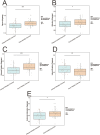Assessment of the efficacy of early versus delayed mobility exercise after arthroscopic rotator cuff repair
- PMID: 40053065
- PMCID: PMC12075342
- DOI: 10.1007/s00264-025-06477-5
Assessment of the efficacy of early versus delayed mobility exercise after arthroscopic rotator cuff repair
Abstract
Purpose: Rotator cuff tears were a prevalent cause of shoulder pain and impairment, often necessitating arthroscopic rotator cuff repair. The optimal timing of postoperative mobilization initiation remains a subject of debate implicating patient outcomes. Therefore, this study aimed to evaluate the effectiveness of early and delayed mobilization after arthroscopic rotator cuff repair.
Methods: A total of 84 patients who underwent unilateral arthroscopic rotator cuff repair were included in the study and divided into early and delayed mobility exercise groups. Outcome measures included range of motion, shoulder strength, pain assessment, re-tear rates, return to work and pre-injury activity, as well as patient-reported outcomes at various postoperative time points.
Results: Early mobility exercise after arthroscopic rotator cuff repair led to a significantly greater recovery of range of motion at six weeks postoperatively (P < 0.05) and shoulder strength at 12 weeks postoperatively (P < 0.05), as compared to the delayed mobility exercise group. However, the early mobility exercise resulted in non-significant excess in the pain assessment at the six-month postoperative mark (P > 0.05). Additionally, there were no statistically significant differences between the two groups in several outcome measures, including re-tear rates, return to work and pre-injury activity, and long-term patient-reported outcomes at one year post-operatively (P > 0.05).
Conclusion: Both early and delayed mobilization exercises safely improve range of motion, shoulder strength, and pain relief after arthroscopic rotator cuff repair. Early mobilization within six to 12 weeks post-surgery enhances range of motion and strength without increasing re-tear rates.
Trial registration: Not applicable.
Keywords: Arthroscopic rotator cuff repair; Delayed mobility exercise; Early mobility exercise; Efficacy.
© 2025. The Author(s).
Conflict of interest statement
Declarations. Human ethics and consent to participate: The study was conducted in accordance with the Declaration of Helsinki. This study was approved by the Ethics Committee of Guangyuan Central Hospital in accordance with regulatory and ethical guidelines pertaining to retrospective research studies. Informed consent was waived for this retrospective study due to the exclusive use of de-identified patient data, which posed no potential harm or impact on patient care. Consent for publication: Not applicable. Competing interests: The authors declare no competing interests. Clinical trial number: Not applicable.
Figures



Comment in
-
Letter to the editor regarding the Article "Assessment of the efficacy of early versus delayed mobility exercise after arthroscopic rotator cuff repair".Int Orthop. 2025 Aug;49(8):2001-2002. doi: 10.1007/s00264-025-06551-y. Epub 2025 May 10. Int Orthop. 2025. PMID: 40347266 No abstract available.
Similar articles
-
Is the Use of a Buprenorphine Transdermal Patch More Effective Than Oral Medications for Postoperative Analgesia After Arthroscopic Rotator Cuff Repair? A Randomized Clinical Trial.Clin Orthop Relat Res. 2025 May 1;483(5):857-865. doi: 10.1097/CORR.0000000000003303. Epub 2024 Nov 5. Clin Orthop Relat Res. 2025. PMID: 39499769 Clinical Trial.
-
Early versus delayed rehabilitation following arthroscopic rotator cuff repair: A systematic review.Phys Sportsmed. 2015 May;43(2):178-87. doi: 10.1080/00913847.2015.1025683. Epub 2015 Mar 22. Phys Sportsmed. 2015. PMID: 25797067
-
Manual therapy and exercise for rotator cuff disease.Cochrane Database Syst Rev. 2016 Jun 10;2016(6):CD012224. doi: 10.1002/14651858.CD012224. Cochrane Database Syst Rev. 2016. PMID: 27283590 Free PMC article.
-
Does early motion lead to a higher failure rate or better outcomes after arthroscopic rotator cuff repair? A systematic review of overlapping meta-analyses.J Shoulder Elbow Surg. 2017 Sep;26(9):1681-1691. doi: 10.1016/j.jse.2017.04.004. Epub 2017 Jun 12. J Shoulder Elbow Surg. 2017. PMID: 28619382
-
No Short-term Clinical Benefit to Bovine Collagen Implant Augmentation in Primary Rotator Cuff Repair: A Matched Retrospective Study.Clin Orthop Relat Res. 2025 Mar 1;483(3):442-452. doi: 10.1097/CORR.0000000000003247. Epub 2024 Sep 5. Clin Orthop Relat Res. 2025. PMID: 39236102
References
-
- Patel M, Amini MH (2022) Management of acute rotator cuff tears. Orthop Clin North Am 53:69–76. 10.1016/j.ocl.2021.08.003 - PubMed
-
- Plancher KD, Shanmugam J, Briggs K et al (2021) Diagnosis and management of partial thickness rotator cuff tears: A comprehensive review. J Am Acad Orthop Surg 29:1031–1043. 10.5435/jaaos-d-20-01092 - PubMed
-
- Weber S, Chahal J (2020) Management of rotator cuff injuries. J Am Acad Orthop Surg 28:e193–e201. 10.5435/jaaos-d-19-00463 - PubMed
-
- Baraza N, Simon MJK, Leith JM (2021) Arthroscopic rotator cuff repair without antibiotic prophylaxis does not increase the infection rate. Knee Surg Sports Traumatol Arthrosc 29:3956–3960. 10.1007/s00167-021-06664-y - PubMed
-
- Berthold DP, Garvin P, Mancini MR et al (2022) Arthroscopic rotator cuff repair with biologically enhanced patch augmentation. Oper Orthop Traumatol 34:4–12. 10.1007/s00064-021-00754-3 - PubMed
Publication types
MeSH terms
LinkOut - more resources
Full Text Sources
Medical

